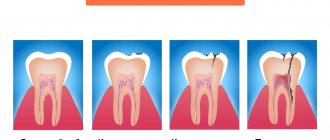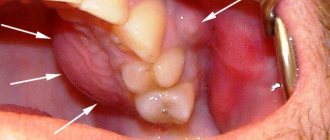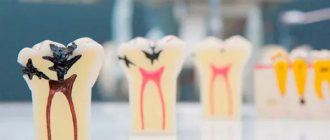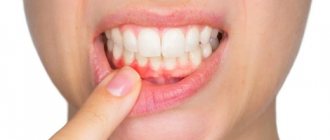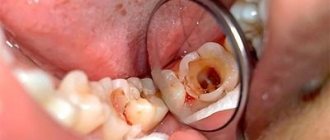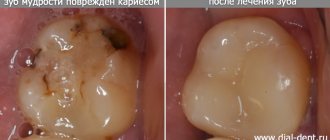Types of chronic periodontitis
Studies of the clinical picture of the possible course of chronic periodontitis and morphological signs made it possible to identify the following types:
- Granulating
With this form of the disease, under a microscope, a noticeable thickening can be observed in the apical part of the tooth root. There is a change in the surface of the periodontium, it becomes uneven. Over time, granulation tissue grows, which causes resorption of bone tissue in the area of inflammation. This process is often accompanied by the appearance of purulent foci, which provokes the appearance of fistulas. In some cases, soft tissue adjacent to the site of inflammation undergoes granulation. This causes the formation of granulomas of various types (submucosal, subperiosteal, subcutaneous), after opening which, fistulas appear on the face and oral cavity, and unaesthetic scars appear at the site of their healing.
Patients experiencing granulating inflammation report pain when chewing solid food, aggravated by pressure, as well as periodic exacerbations of painful conditions.
- Granulomatous
One of the forms of periapical inflammation, characterized by the formation of granulation tissue in the area of the root apex. The maturation of this tissue along the periphery provokes the appearance of a fibrous capsule that degenerates into a granuloma. Depending on the structural features, simple, epithelial and cystic granulomas are distinguished. Quite often, this form of the disease occurs as a consequence of granulating inflammation.
The course of the disease can occur according to various scenarios. Sometimes the granuloma grows slowly or does not grow at all. In this case, it usually does not cause any discomfort and is discovered by chance during an X-ray examination.
In other patients, the granuloma may enlarge, most often coinciding with exacerbations of chronic periodontitis, provoking changes in the granuloma tissue.
- Fibrous
It is characterized by the formation of a limited focus of inflammation caused by the spread of fibrous tissue. Most often this occurs after treatment of the forms of periodontitis described above, but sometimes the fibrous form occurs independently.
Often, fibrous inflammation is accompanied by excessive formation of cement, and in some cases, sclerosis of adjacent bone tissue.
An X-ray examination allows you to determine the form of chronic periodontitis. It is very important to correctly differentiate different types of disease, since the effectiveness of treatment directly depends on this.
Symptoms of periodontitis
It is impossible not to notice the symptoms of periodontitis. These include:
- The occurrence of severe pain that is constant;
- The appearance of painful sensations when chewing or touching;
- A clear feeling of which tooth hurts, with a feeling of bursting from the inside;
- Discharge of a small amount of fluid from under the tooth, accumulation of pus in the gums;
- The pain may be throbbing and radiate to the temporal or ear region;
- Bad breath;
- Visible swelling and redness of the gums.
Causes of chronic periodontitis
In the vast majority of cases, the cause of chronic periodontal inflammation is untreated acute pulpitis. And it, in turn, arises from neglected caries. It is not difficult to guess that the root of all troubles and complications lies precisely in carious spots, which patients tend to ignore.
It is interesting that, unlike most other diseases, periodontitis does not always have an acute stage; in some cases, pulpitis immediately turns into a chronic form of periodontal inflammation, which, without showing itself for a long time, has a destructive effect on the teeth and gums.
Quite often, the chronic stage is still preceded by an acute period of the disease, but many tend to delay treatment, preferring to relieve the pain with medication. As a result, the tooth stops hurting and the patient calms down, but meanwhile the inflammatory process gains momentum, so that later it can express itself fully.
If you do not want to become a victim of chronic periodontitis, then go for a consultation with a dentist as soon as you notice one of the following signs:
- pain that appears when chewing and biting hard foods, as well as pain of a periodic or pulsating nature;
- a feeling of a tooth protruding, preventing you from closing your jaw;
- swelling of the gums and irritation of the oral mucosa in the area of the diseased tooth;
- tooth mobility caused by periodontal destruction;
- the occurrence of one or more fistulas;
- inflammation of the submandibular lymph nodes, observed from the side of the inflammation.
Do not delay visiting your doctor, even if the symptoms are mild.
Why does periodontitis occur and can it be cured?
“Doctor, they told me I have a “cyst” - how often we hear this phrase at appointments and it sounds like a sentence.
So what is this insidious enemy and can it be defeated? In order to answer this question, it is necessary to understand the mechanism of development of this pathology and understand the cause.
Apical periodontitis (“cyst”) is an inflammatory process, usually located in the area of the root apex and on a radiograph having the appearance of a radiolucent focus (a focus of radiological clearing, or, in simple terms, a dark “ball” with rounded contours). Basically, it is chronic in nature and in most cases does not bother you at all, but under certain circumstances an exacerbation of the process may occur.
Before we talk about the cause, let's look at the structure of the tooth and try to figure out which structures are involved in the development of periodontitis.
A tooth has a crown and a root, which consist of hard tissues (enamel, dentin, cement). Inside the tooth (in the root canal) there is a pulp - this is a neurovascular bundle that is responsible for the nutrition and vitality of the tooth. The periodontium (periodontal ligament) is a complex of tissues (fibers) that hold the tooth in the bone.
The pulp and periodontium are directly involved in the development of apical periodontitis.
When caries is advanced, zones of necrosis form in the pulp, which creates favorable conditions for the development of microbes.
In the periodontium of formed teeth there are residual Malasse cells - these are epithelial cells that previously formed structures during tooth development. Under normal conditions, they have no function and do not manifest themselves in any way.
So, we come to the main question: why does periodontitis occur?
The main reason is the entry of infection (microorganisms) into the lumen of the root canal. What does this lead to?
The cells of our immune system begin to react to the presence of microbes and their toxins and release various substances (inflammatory mediators, cytokines, growth factors) that trigger the process of Malassé cell division, resulting in the formation of a group of cells that is capable of further increase. They form the cyst shell. Pus forms inside the cavity over time as a result of immune cells fighting infection. Over time, this formation grows and destroys bone tissue.
That is, in this way our body tries to build a barrier (immune response) so that microbes cannot go further beyond the root canal.
How can infection get into root canals?
- Untimely treatment of caries. Over a long period of time, the carious process reaches the dental pulp and leads to the development of pulpitis (acute or chronic). In the absence of treatment or if the patient has “suffered” acute pain, the nerve may die, which will lead to the formation of a zone of necrosis and the proliferation of microorganisms, and, accordingly, the development of apical periodontitis.
In this case, on the x-ray we see a deep carious cavity on the contact surface of the 35th tooth and a periapical lesion in the area of the root apex.
- Incomplete treatment of pulpitis in time. Periodontitis can develop due to the action of certain medications, as well as a violation of the tightness of temporary fillings, when microbes from saliva penetrate the tooth.
Let's look at an example of a clinical case.
Natalya, we went to the clinic for comprehensive treatment.
Endodontic treatment of teeth 15 and 26 was started six months ago, but for certain reasons it was not completed
.
Objectively, in the oral cavity there are temporary fillings on teeth 15 and 26, the tightness of which is broken over time, and microbes from the oral cavity can enter the tooth and infect the root canals.
CBCT shows signs of apical periodontitis
.
- Poor quality treatment
- Lack of insulation (use of rubber dam)
- Failure to comply with the rules of asepsis and antisepsis (not removing plaque and/or carious tissue before treatment, using unsterile instruments, etc.)
- Missed root canals, in which the nerve may die over time and cause tissue necrosis (very often occurs in upper molars due to their complex anatomical structure)
- Leaky restoration after endodontic treatment. The integrity of composite fillings is compromised over time; they can chip and microbes from the oral cavity can infect the root canals.
So, we figured out the mechanism of the emergence of our insidious enemy. So is it possible to defeat him? The answer to this question is yes. All you have to do is remove the infection from the root canals! There will be no microbes, the cells of the immune system will stop sending signals to the Malasse cells, the process of their division will stop and the periapical lesion will regress over time (heal through apoptosis - programmed cell death), and victory will be ours!
It is also important to understand that microorganisms inside the canal do not sit alone, but are part of a biofilm - this is a stationary multicellular microbial community tightly attached to the canal wall and surrounded by a special matrix. It is quite thick and consists of several layers of cells. Therefore, mechanical and medicinal treatment of root canals has a special role.
Modern technologies make it possible to carry out high-quality endodontic treatment and achieve good results.
What we have in our arsenal:
- Increase. The use of an operating microscope significantly improves the quality of treatment through good visualization of the quality of cleaning of the root canal system and the search for additional canals
- Careful isolation - rubber dam
- Computed tomography is an important diagnostic tool
- Modern rotary instruments for canal machining
- Disinfectant solutions (the main irrigant is sodium hypochlorite, which not only kills most microbes, but also dissolves organic matter)
- Ultrasound to improve irrigation quality
- High level of prosthetic dentistry, allowing the creation of functional restorations with good sealing
All this together helps us cure apical periodontitis, and during primary endodontic treatment (treatment of pulpitis) reduce the risk of infection.
But, unfortunately, there are cases in which we are powerless and we fail to achieve positive dynamics. Infected lateral canals and anastomoses, infected apical fissures, infection outside the root canal are factors that the endodontist cannot physically treat. This is where apical surgery can come to our aid.
It is also important to remember that when trying to save teeth with apical periodontitis, it is necessary to take into account the degree of tooth destruction and the prognosis for further restoration from the orthopedic dentist.
And don’t forget that the best medicine is prevention!!! Regular preventive examinations and timely treatment of caries will help avoid the occurrence of apical periodontitis. Monitoring endodontically treated teeth will help to detect complications in time and prevent them. As well as compliance with all doctor’s recommendations (attending appointments on time, covering teeth with crowns after endodontic treatment, regular follow-up examinations).
Basic principles of treatment of chronic periodontitis
The choice of treatment methods and means depends on what form of the disease is diagnosed. They can be either conservative or surgical.
The first stage of treatment will be tooth sanitation. During the procedure, the doctor thoroughly cleans the dental canals and tooth cavity, ridding them of carious lesions and infected tissues. Then all cleaned cavities are treated with special antiseptic preparations, and after the doctor is convinced that the inflammatory process has stopped, a permanent filling is placed.
In advanced and complex situations, surgical treatment may be recommended. There is no need to be afraid of this, since doctors always strive to save the tooth by removing only the infected tissue. If therapy is powerless, then resection of the root apex, tooth replantation, cystotomy or cystectomy can be performed. In this case, an effective, but most gentle method is always chosen, which allows you to achieve the desired result while minimizing unpleasant sensations for the patient. Tooth extraction, as a surgical method, is used only in the most extreme cases.
What to do if your tooth hurts after treatment.
If the pain that bothers you after a visit to the dentist is not pronounced, gradually decreases over time and there is positive dynamics, you just have to rely on the strength of your body and wait for a complete recovery. However, acute, severe and paroxysmal pain that does not subside but increases over time, swelling and fever are sure signs that it is time for you to see a doctor. The specialists of the Vega Dent clinic will help you find out the causes of toothache and, if necessary, provide qualified medical care.
Exacerbation of periodontitis: symptoms and treatment
Most often, chronic periodontitis is detected during exacerbations. It is even often initially mistaken for an acute form, but additional signs revealed by studying x-rays and the patient’s condition make it possible to establish an accurate diagnosis.
The main symptoms of exacerbation of chronic periodontitis are in many ways similar to those observed in the acute form of the disease, and the treatment regimen in both of these cases is the same. It is carried out in several stages.
At the first visit, the doctor opens the pulp chamber and removes the nerve, after which he thoroughly cleans the canals and cavity of the tooth, creating conditions for the outflow of pus. After this, the exposed tooth must be rinsed for several days with a soda solution in order to wash out the remaining purulent masses.
During the second visit, medications are placed into the canals and the cavity of the tooth, which are closed with a temporary filling. The aching tooth is left in this state for 1-2 weeks.
After this, if the control image does not cause alarm, the temporary filling is replaced with a permanent one.
In some cases, exacerbation of chronic periodontitis makes itself felt after completion of treatment. To relieve its symptoms, anti-inflammatory therapy is prescribed, which can be supplemented with physiotherapeutic procedures.
Dental periodontitis: what it is, how to treat it
| Treatment of periodontitis always begins with a doctor analyzing the patient’s complaints and studying the image. Only after this will it be possible to understand whether a tooth will need to be removed due to periodontitis, or whether it can be saved! |
Treatment of periodontitis: stages
- If the disease has reached an acute stage, then the doctor’s first priority is to create an opportunity for the pus to flow out, since otherwise it will not be possible to get rid of the acute pain.
- The crown (if any) is removed, the root canals are unfilled (this must be done on the patient’s first visit).
- If the gums are swollen, the abscess will need to be opened.
Open root canals will allow the pus to drain freely, which will significantly relieve the pain. In addition to this, the dentist will prescribe antibiotics and rinses. A repeat visit is scheduled no earlier than two to three days later. If the pus no longer drains by this point, an antiseptic drug is placed in the canals.
Further methods of treating periodontitis will largely be determined by the size of the inflammatory focus.
Treatment of acute periodontitis of the tooth
The acute stage of the disease is accompanied by severe pain, forcing the patient to consult a doctor as soon as possible.
During the visit, the doctor removes the pulp (the root canals are not closed, since a path is needed for the pus to exit). A crown or filling may need to be removed. If the gums are swollen, the dentist may decide to make an incision to facilitate the release of purulent masses.
In most cases, these measures are enough to make the pain go away. In addition to surgical measures, the patient is prescribed drug therapy in the form of taking oral antibiotics and rinsing with them.
After 4 days, a follow-up visit is scheduled, during which the doctor checks whether all the pus has come out. To achieve final cleaning, an antiseptic is placed into the tooth.
Then, with the help of medications, the inflammatory process is relieved, and the canals are sealed. In some cases, bone tissue restoration and long-term anti-inflammatory therapy may be required. Sometimes a doctor may find it advisable to get rid of a cyst using a laser.
Treatment of chronic periodontitis
Treatment of the fibrotic form involves several visits to the doctor over the course of a week. Since the upper part of the root is not changed, the technique allows you to fill the canals at the next visit to a specialist.
But the treatment process for granulating and granulomatous periodontitis can take a couple of months, especially if there is a complication.
The following procedures are carried out first:
- a picture is taken;
- under anesthesia, carious areas are drilled and access to the canals is provided;
- if the tooth has not been treated, the pulp is removed, if it has been filled, then the canals are unsealed;
- the channels are expanded and treated with an antiseptic solution;
- until the patient’s next visit to the doctor, an antiseptic is placed in the canals (usually Cresophenon is used);
- a temporary filling is placed;
- Anti-inflammatory drugs may be prescribed (but this is not always done).
The next visit is scheduled in three days:
- the previously placed temporary filling and the medicine placed in the canals are removed;
- the channels are thoroughly washed with antiseptics;
- The canals are filled and then a temporary filling is placed again.
On last visit:
- a picture is taken that makes it possible to understand how successful the tooth restoration after periodontitis was;
- The filling material is removed from the canals and treated with an antiseptic;
- the channels are sealed;
- Another picture is taken to determine whether the canals have been sealed to their entire length, otherwise the disease may begin again after some time.
If the size of the cyst exceeds 1.5 cm (cases have been recorded when the formation can grow up to 5 cm), then after filling, root resection and subsequent restoration of the tooth are performed.
Why is chronic periodontitis dangerous?
The anatomical structure of the teeth ensures in most cases the free outflow of serous and purulent masses from the source of inflammation. As a result, the patient may not be aware of the presence of chronic periodontal inflammation for a long time. All this time it is actively developing, exposing tissues to destruction. Sometimes this leads to the fact that it is no longer possible to save the tooth.
In addition to tooth loss, chronic periodontitis leads to the formation of skin or gingival fistulas and various types of granulomas, which require long-term (several months) complex and expensive treatment.
Granulomatous formations pose an additional danger. They can, under the influence of such unfavorable factors as stress or hypothermia, lead to the development of serious inflammatory processes, including sepsis.
Chronic periodontal inflammation can also accelerate the progression of diseases such as nephritis, arthritis and rheumatism, and provoke other health problems.
Mistakes in the treatment of periodontitis
Medical errors acceptable in the treatment of periodontitis, or errors arising for other reasons, can cause complications such as the appearance of a fistula, cyst and osteomyelitis. These complications are called local. But there are also general complications. These include intoxication of the body and infection (sepsis) of the blood. Therefore, to treat a disease such as periodontitis, you should contact only qualified specialists. All complications that arise during the treatment of periodontitis require immediate medical intervention. Let's take a closer look at local complications.
- Fistula. A fistula occurs as a result of poor-quality tooth filling, which causes bacteria to multiply inside it. An inflammatory process appears and a fistula is formed, through which pus is released. Treatment is carried out by taking antibiotics and antihistamines, as well as rinsing with saline solution. If treatment is carried out correctly, the fistula will close on its own.
- Cyst. The formation that occurs in the upper part of the tooth is called a cyst. It develops slowly and does not cause concern. As the size of the cyst increases, complications begin. The cyst is diagnosed using an x-ray and removed surgically using local anesthesia.
- Osteomyelitis. An infectious disease that can lead to the breakdown of the jaw bones. Diagnosis requires a complete examination, including a blood test, x-rays and other tests. For treatment, it is necessary to remove the diseased tooth and then take antibiotics.
It is known that the best prevention of diseases is their prevention. You shouldn’t put off going to the dentist for a long time, even if you have minor caries. Take care of your teeth, and then you will avoid serious dental diseases, have healthy teeth and a beautiful smile.
Prevention of periodontal inflammation
In order not to encounter chronic periodontitis, avoid complications of dental diseases such as pulpitis and caries. Treatment of caries in all cases is much simpler and faster, and it costs much less than the fight against inflammatory processes in the periodontium.
Remember that regular visits to the dentist once every six months can keep your teeth healthy and protect you from large financial expenses in the future.
In addition, strictly observe oral hygiene, using only high-quality toothpastes to brush your teeth, for example, ASEPTA SENSITIVE, which is specially designed to prevent inflammation of the teeth and gums, as well as provide gentle care for sensitive enamel. The carefully selected ratio of enzymes, thermal mud and herbs in its composition ensures maximum therapeutic and prophylactic effect.
ASEPTA mouthwash will also provide invaluable assistance in creating a healthy microflora that prevents the occurrence of periodontitis. Its regular use can significantly reduce the number of pathogenic microorganisms in the mouth, which most often cause infectious inflammatory processes.
Preventive measures also include a healthy diet. Try to eat as many fresh vegetables and fruits as possible, while simultaneously reducing the amount of sweets and carbohydrates in your diet.
Remember that some medications and orthodontic appliances can also have a destructive effect on teeth. Be sure to use additional oral care products while wearing braces and dentures, as well as in cases when you are forced to take medications that are harmful to tooth enamel.
Take full care of your dental health, and they will not make you experience pain and unpleasant emotions.
Possible causes of pain
After treatment of periodontitis, discomfort may persist for 7-14 days. This is due to injury to the tooth tissue. If you follow the recommendations of your doctor, regeneration will accelerate and discomfort will disappear.
If the pain persists for longer, you should consult a specialist. The main reasons for this problem include:
- poor-quality filling – lack or excess of filling material;
- the presence of foreign bodies in the root canals – most often these are elements of dental instruments;
- the emergence of a new focus of inflammation - due to the spread of pathogenic bacteria, tooth tissue can become inflamed again.
These are the most common causes of tooth pain after treatment. A doctor will help determine the provoking factor.
Pain after pulpitis treatment
Pain after treatment usually lasts up to 2 months. The main reason is periodontal injury at the root apex. It cannot be avoided, since the pulp, the neurovascular bundle, was removed and ruptured from the tooth. There is no reason to worry if the pain is not severe and does not significantly impair the quality of life, and also becomes less intense every day. In the second month it is not constant, but appears only when pressure is applied to the tooth.
The following symptoms should alert you:
- pain 2 months after treatment;
- not a decrease, but an increase in pain every day;
- severe pain (it prevents the patient from sleeping and doing everyday activities);
- swelling.
If such signs appear, consult a doctor immediately. They indicate that the nerve was not completely removed. It may also be due to poor quality work by the doctor or due to the individual characteristics of the patient’s tooth structure. Remains of tissue rot and cause inflammation.
How much does it cost to cure acute and chronic periodontitis in Moscow?
The cost of periodontitis treatment in Moscow clinics depends on the following factors:
- the number of canals that need treatment and filling;
- volume of mechanical interventions;
- the number of medications used in the treatment of a pathological tooth and in treatment in general;
- general condition of the oral cavity and possible pathologies that accompany periodontitis and require treatment;
- type of filling;
- the need for artistic restoration after filling;
- number of x-rays;
- type of anesthesia.
The estimated price for treatment of a 1-channel unit in Moscow clinics is from 7,500 rubles.
Treatment of a two-canal tooth costs approximately 9,500 rubles in Moscow.
Treatment of chronic periodontitis of a three-channel tooth will cost the patient from 12 thousand rubles.
Thus, treatment of periodontitis is a rather lengthy and expensive procedure that will require several visits to the clinic. To protect yourself and your loved ones from such difficulties, it is enough to simply visit the dentist’s office for preventive maintenance once every six months and brush your teeth regularly.
The 32 Dent clinic in Moscow specializes in complex treatment of periodontitis even in the most advanced cases. Sign up for an initial consultation with a specialist to receive qualified dental care on time, eliminating the risk of complications.


